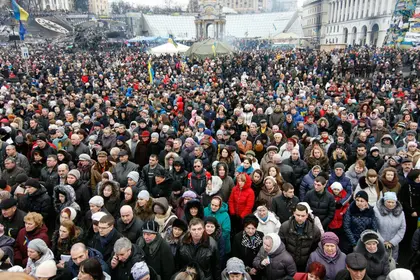A meme appeared on social media shortly after Russia’s full-scale invasion of Ukraine began on Feb. 24, 2022: “This is the third day of an eight-year war that Ukraine has been fighting with Russia for more than three and a half centuries.”
But if we want to be sticklers for dates, then Nov. 30, 2013 is as good a day as any to mark the beginning of the ongoing war in Ukraine.
JOIN US ON TELEGRAM
Follow our coverage of the war on the @Kyivpost_official.
Why? Nine days prior to that date, on Nov. 21, students in Kyiv descended into Independence Square – better known as the Maidan – in order to protest President Viktor Yanukovych’s decision to renege on a long-prepared EU Association Agreement. On Nov. 30 the peaceful demonstrators were attacked by riot police.
Euromaidan
The students dubbed the demonstration “Euromaidan.” They wanted to recreate the peaceful Orange Revolution in the winter of 2004-05, which had overturned the fraudulent election of Yanukovych and ushered in the presidency of Viktor Yushchenko.
Fast-forward to 2010 and Yanukovych made a remarkable political comeback, winning what most deemed to be free and fair elections. For three years Ukrainians had more or less accepted the corruption that followed, largely because of the promise that cooperation with the EU would bring an end to it.
But reneging on the EU Association Agreement, which 52 percent of the population supported, was too much.
Around 2,000 students came out to peacefully demonstrate their dissatisfaction. They hoped they could duplicate the pressure exerted in 2004 by turning the Maidan into a revolutionary winter festival of music and free expression.

Trump Makes 90 Day Foreign Aid Freeze – Ukraine Military Support Supposedly Untouched
Unfortunately, Yanukovych would broach no repeat of 2004. Within nine days of the first protests, when it looked as if they they could attract tens of thousands to join them, Yanukovych sicced his Interior Ministry riot squad, the Berkut, against the protests. They attacked in the early hours of Saturday morning, Nov. 30. It was to set off a progressive escalation of violence that has led us to where we are today.
The Nov. 30 attacks on the students ignited sporadic riots in the following days. Thousands more Kyivites descended on the Maidan. The protesters were joined by Afghantsi – veterans of the Soviet war in Afghanistan – many of whose children had been attacked by Berkut truncheons.
As one Afghan vet told a TV reporter at the time: “If they start beating our children today, then it’s just a matter of time before they’ll be beating all of us.”
It was soon very clear that these demonstrations, which would be called the “Revolution of Dignity,” would not be as peaceful as the Orange Revolution. All sides began preparing for an escalation – most notably Yanukovych’s Moscow sponsor.
New genealogical investigation into Russia's war
As if to underscore the initial spark that led to this war now raging across a 1,000-kilometer front, Russian investigative journalist Andrey Zakharov, who worked for the BBC’s Russian service for many years, released a video called “His War.” The documentary is an investigation into how Vladimir Putin actually engineered and unleashed the war in Ukraine back in 2014.
“For 10 years now,” Zakharov says, “journalists from around the world have been gathering evidence on how exactly this war began. In this film, we have compiled all the evidence together. This includes wiretaps of conversations among Russian officials and separatists, email leaks, and most importantly, confessions from the participants of the ‘Russian Spring.’”
Despite an avalanche of Russian propaganda over the years maintaining that the Revolution of Dignity was actually a coup sponsored by the United States or George Soros or some other Russophobic cabal of neo-Nazis, the evidence is quite clear. Moscow intended to restore its sphere of influence, lost with the collapse of the Soviet Union, and it was willing to use violence and asymmetrical (“hybrid”) methods to achieve its goal. Controlling Kyiv was the cornerstone of that strategy.
Today, we see the result. Many thousands of dead, Ukrainian cities razed to the ground, the world on the brink of all-out war, and Ukrainians still resisting. Because even 10 years ago, many realized they had no other alternative.
You can also highlight the text and press Ctrl + Enter










